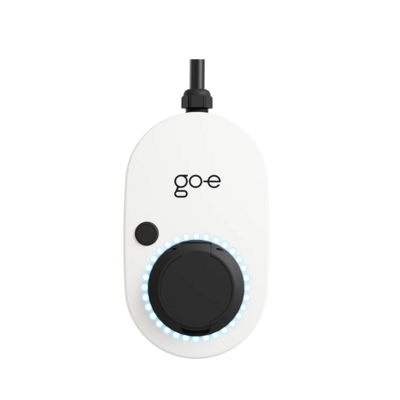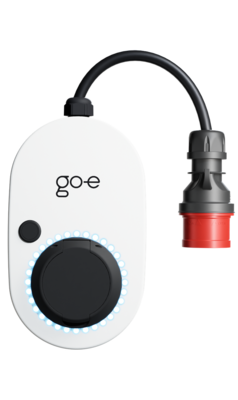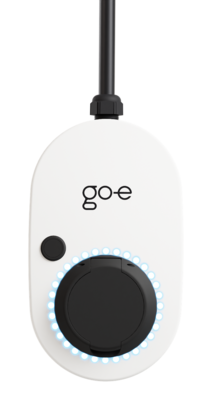DC Charging Stations Explained
A DC charging station is normally a public electric vehicle charging station that provides lightning-quick charging of up to 350 kW.
It charges the battery super fast, but it also shortens its lifespan. And if you compare its cost with the cost of home charging with a go-e Charger... well, you're going to be impressed.
Wanna know more about DC charging? Follow us.
How Fast Can I Charge with a DC Charging Station?
Imagine it’s early morning, and you’re nearly late for an important meeting at work. You’re playing the scenario of the future discussion with partners in your head, trying to find the right morning music track, when you suddenly realise your car battery is about to hit zero. What a nasty surprise!
Right now, if you see a DC charging station on the road, it might just save your day. You can have a nearly fully charged battery with this charging option in 20 to 60 minutes. It depends on your car capabilities and maximum charging output of the DC charger. Anyway, if you only need an extra 20% or 30% to get to work, this will certainly be helpful.
You should know that there are two main types of DC charging:
- standard DC charging
- high-power charging (HPC).
Charging at speeds of up to 50 kW is referred to as standard DC charging. With this speed, you can recharge a Renault ZOE with a 52 kWh battery from 0% to full in roughly one hour.
HPC is a type of DC charging that occurs at substantially greater speeds, often ranging between 150 and 350 kW. For instance, with a 350 kW DC charger, Hyundai IONIQ 5 can charge from 10 percent to 80 percent in just 18 minutes.
While both methods of charging technically use DC current, HPC charging is distinguished by much faster charging speeds as compared to normal DC charging.
How to find DC Charging Stations?
HPC charging stations are often located along highways. Finding a regular DC charger close to the city centre or at a supermarket parking is hardly a surprise, though.
Just one app is enough to find and access various charging stations from different providers. Many car brands provide such apps (e.g. Charge myHyundai for Hyundai owners). Numerous charge point operators (CPO) now offer roaming, so you don't always need more apps even if you’re travelling abroad.
However, it's smart to have a contract with a provider because charging costs may vary. You can also use your provider's charging card with RFID which is convenient. Within the app of the charge point operator, you'll often find a map displaying the charging stations within the company's network.
Note: Soon, new laws will allow you to pay at charging stations with an ATM or credit card.
Services to locate DC Charging Station
To search the nearest DC charging station, you can use an app, the navigation system of the car or websites such as ChargerFinder or Chargemap. In most cases, you can see the locations of both AC and DC charging stations as well as their status and top speed.
How do I Use a DC Charging Station?
First, make sure your car supports DC charging as some such as Smart EQ ForTwo do not.
Next, you need to connect the charging cable to the specific DC charging port on your electric car in order to use this sort of charging. No need to bring your own cable as it's already attached to the DC charger.
You have either a CCS (Combined Charging System) or CHAdeMO port for quick charging, depending on your car. Fortunately, the main DC charger producers allow charging via CCS or CHAdeMO from the same unit. This implies that you can charge any type of electric vehicle.
Note: HPC chargers in Europe no longer offer CHAdeMO plugs, and there is a growing trend of dismantling DC charging stations with CHAdeMO connectors. In the future, Europe will predominantly rely on CCS (Combined Charging System) for DC charging.
How Much Does it Cost to Charge at a DC Charging Station?
Different DC charger providers in different countries offer different tariffs. But that’s not what you want to hear, is it? So we found some estimates for you.
When it comes to DC charging costs, speed is the name of the game. Let's take the Dutch charging network Allego, which operates in Germany, as an example. The prices offered by the provider are the following:
- Regular charging (up to 22kW): 0,60 EUR/ kWh
- Fast charging (up to 50kW): 0,75 EUR/ kWh
- Ultra-fast charging: ( more than 50kW): 0,85 EUR/ kWh
Prices may also change over time. So keep an eye out for the best offer that suits your needs.
AC Charging Stations vs DC Charging Stations
Despite the growing popularity of home chargers for electric cars, you can’t ignore the practicality of public charging stations, which can be either Alternating Current (AC) or Direct Current (DC). Home chargers like our go-e Charger, on the other hand, are always AC.
go-e Charger Gemini 11 kW

The compact wallbox for stationary use, at home or at the workplace. Simple installation, intuitive operation and smart comfort functions. Charging power from 1.4 kW to 11 kW. 1-phase or 3-phase charging.
go-e Charger Gemini flex 11 kW

The intelligent wallbox can be used both stationary in the wall bracket and mobile. No electrician is required for the installation of the charging station. Charging power from 1.4 kW to 11 kW. 1-phase or 3-phase charging.
go-e Charger Gemini 22 kW

The compact wallbox for stationary use, at home or at the workplace. Simple installation, intuitive operation and smart comfort functions. Charging power from 1.4 kW to 22 kW. 1-phase or 3-phase charging.
go-e Charger Gemini flex 22 kW

The intelligent wallbox can be used both stationary in the wall bracket and mobile. No electrician is required for the installation of the charging station. Charging power from 1.4 kW to 22 kW. 1-phase or 3-phase charging.
If you’re looking for a clear distinction between your charging options, here it is.
| # | AC home charging | AC public charging | DC public charging | HPC public charging |
|---|---|---|---|---|
| Speed | Up to 22 kW | Up to 22/43 kW | Up to 50 kW | Up to 350 kW |
| Price | Low | Medium | High | High |
| Location | Wherever is convenient for you | Public places, such as car parks, gyms, and shopping malls | Public places, such as car parks, gyms, and shopping malls | Normally along highways |
Why is DC charging faster than AC charging?
Electricity from the grid is typically Alternating Current (AC), while electric car batteries only accept Direct Current (DC).
Do you want to allow Integration of youtube videos?
Allows the playback of videos, that are hosted on youtube.com. By allowing this feature, you accept the privacy agreement of google.
Accordingly, a conversion is needed.
Where this conversion takes place is one important distinction between AC and DC charging. The conversion from AC to DC occurs within the vehicle when using AC charging. Because the process takes place within the car, AC chargers are often smaller in size but charge the battery more slowly.
On the contrary, a converter is already present inside the charging station for DC chargers. Due to the external nature of the conversion process, DC chargers are bigger than their AC counterparts but also charge batteries faster.
DC Charging for Electric Cars: Pros and Cons
Let’s look at the bright side first. What’s good about DC chargers:
- Outstanding speed
We can blame super-fast charging for many things, but not for its charging speed. Doing it in 15 minutes rather than two hours is like discovering a hidden treasure when you're in a rush and can't afford to spend that much time charging.
- Convenient when driving on a highway
When travelling cross-country or simply making the commute to work, you always have a charging option thanks to the presence of DC/HPC charging stations along highways.
Now it’s time to take a look at the drawbacks of DC rapid charging.
- Not all cars can charge super-fast
The rule for charging an electric car is that the maximum charging speed is determined by the lower of the two values between the charging speed of the car and the charging speed of the charger. For example, a Fiat 500 connected to a DC charging station has a maximum charging capacity of 85 kW.
- Battery degradation
Due to the heat and stress it causes, DC charging can harm your car battery. The battery is charged more quickly and can eventually wear out faster, given the steeper charging curve of DC charging. However, the extent to which your battery is damaged depends on how often you use DC chargers. Relaxed home charging with the go-e Charger, on the other hand, powers your electric vehicle in the most gentle way.
- Higher cost
Public DC charging can be twice as expensive as public AC charging and about three or four times as expensive as AC charging at home.
Summary
Choosing between AC and DC charging stations may seem daunting, but the decision is actually quite simple.
If you're in a hurry and need to get back on the road as soon as possible, a DC charging station might be the best choice for fast and efficient charging. On the other hand, if you commute regularly or have enough time to plan charging in advance, a home AC charging station, such as our go-e Charger Gemini, can provide a reliable and cost-effective charging solution.
But what if you are often on the road and want to charge your car wherever you are? In this case, our mobile go-e Charger Gemini flex is the way to go. Whether you're visiting friends in the countryside or going on a camping trip next weekend, put the wallbox in the back of your car and drive off without worrying. If your friends have a red CEE socket, you can simply plug in the charger and start charging immediately. It's also no problem if they don’t have one. With the original go-e adapter, you can charge at a normal socket (charging speed will be lower) or camping plug, for example.
